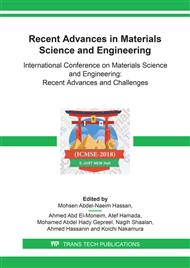p.128
p.134
p.149
p.159
p.165
p.174
p.197
p.206
p.215
Use of Gamma Ray Back Scattering Method for Corrosion Assessment in Insulated Pipes
Abstract:
Corrosion of insulated pipes is a major problem in nuclear,petrochemical and other industries.This type of corrosion is difficult to measure by the available techniques of ultrasound and transmission gamma or x-ray radiography due to the presence of insulating material and limited accessibility to both sides. Gamma-ray backscattering technique is a non-contactmethod and is highly suitable for buried insulated pipes where access is limited to one side only.In the present work, MCNP5 code was used to simulate a case where pipe corrosion (i.e., wall thinning) was measured by gamma backscattered technique. A steel pipe is bombarded by collimated gamma ray beam of 1 cm diameter from an 8 mCi137Cs source. The pipehad different wall thicknesses and was wrapped with a commercially available insulator. Upon interaction with the pipe wall, a 2x2 cm NaI (Tl) scintillation detector was used to measure the scattered radiation due to Compton scattering. The codewas used to evaluate the sensitivity of the device to predict pipe wall thinning as an indication for pipe corrosion. Then, parametric analysis was done to investigate the effects of pipe diameter, insulator thickness, source collimator diameter, source shield thickness as well as the thickness of the shied between the source and the detector on the device response. Effect of empty vs. water-filled pipes on the device response was also investigated. Results indicate that Gamma-ray backscattering technique can be used successfully as a non-destructive test for measuring wall thinning of insulated pipes as an indication of their corrosion.
Info:
Periodical:
Pages:
165-173
Citation:
Online since:
October 2018
Price:
Сopyright:
© 2018 Trans Tech Publications Ltd. All Rights Reserved
Share:
Citation:


